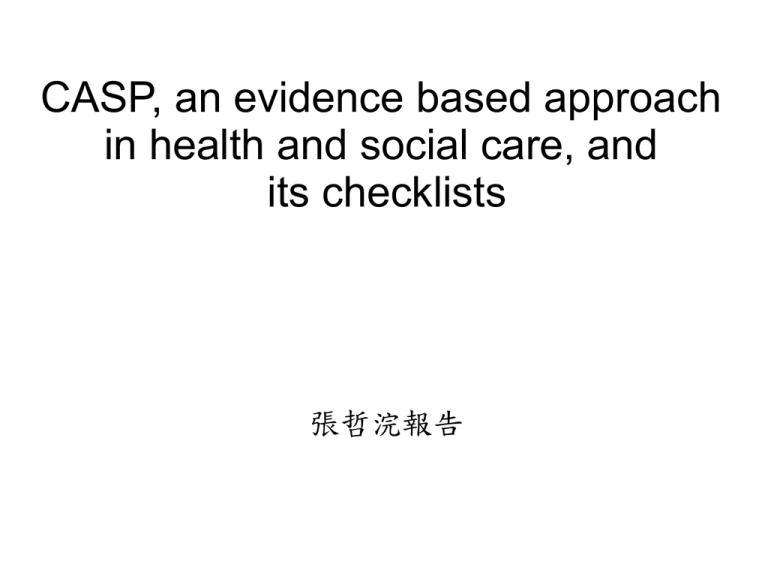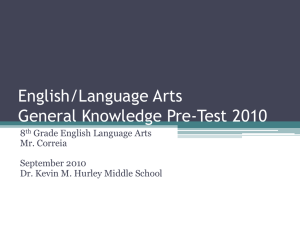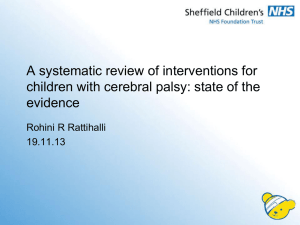
CASP, an evidence based approach
in health and social care, and
its checklists
張哲浣報告
CASP, an evidence based approach
in health and social care
整個CASP是一種包含EBM的方案
特色是在評讀方面
CASP 目標(for health and social care) ≧ an
EBM program; 但策略類似,特色使用的
checklists
Ps:是否可做為寫作的checklists?
何謂 CASP
CASP 為 Critical Appraisal Skills Programme 之
縮寫.
Critical appraisal is the process of carefully
and systematically examining research
to judge its trustworthiness (可信賴), and its
value (價值) and relevance (關聯) in a particular
context.
目的:了解證據(Make sense of evidence).
CASP標準動作
Find
Appraise (檢驗判斷)
Act (做)
CASP 起源
CASP是由英國健保(NHS)的公共衛生資源部門
所發展的文獻評讀工具,其中critical
appraisal tools針對各種不同研究設計提供不
同的評讀表單資源
The Critical Appraisal Skills Programme
(CASP) was developed in Oxford in 1993 and
has since helped to develop an evidence
based approach in health and social care,
working with local, national and
international partner organisations.
workshops and resources
CASPs workshops and resources aim to help
participants put knowledge into practice by
learning how to
1.systematically formulate questions,
2.find research evidence,
3.appraise research evidence and
4.act on (照著...做) what they find.
CASP─ Find, Appraise, Act
The Critical Appraisal Skills Programme helps
people acquire skills in making sense of
scientific evidence about health care.
This is because in order to make use of the best
available evidence from scientific research, we
need to be able to :
The CASP International Network
(CASPin)
A non-profit making organisation for people
promoting skills in finding, critically appraising
and acting on research evidence. CASPin has
been an informal network since 1998, and
members have developed similar critical
appraisal skills programmes in Spain (CASPe),
Hungary, Poland, Romania, Japan, Norway and
India. Many individuals have organised CASP
workshops in about 30 other countries, settings
and audiences, particularly South America, and
Central and Eastern Europe.
The Creative Commons License
A set of eight critical appraisal tools to use when
reading research, these include tools for
Systematic Reviews. Randomised Controlled
Trials, Cohort Studies, Case Control Studies,
Economic Evaluations, Diagnostic Studies,
Qualitative Studies and Clinical Prediction Rule.
These are free to download and can be used by
anyone under the Creative Commons License.
CASP八種checklists (討論前四項)
CASP Randomised Controlled Trial
CASP Systematic Review
CASP Cohort Study
CASP Case Control Study
CASP Qualitative Research
CASP Economic Evaluations
CASP Diagnostic Test
CASP Clinical Prediction Rule
Clinical trial-classifying clinical trials is by the way
the researchers behave
In an observational study, the investigators
observe the subjects and measure their
outcomes. The researchers do not actively
manage the study in both the treatment and the
assignment of subjects.
In an interventional study, the investigators
give the research subjects a particular medicine
or other intervention. Usually, they compare the
treated subjects to subjects who receive no
treatment or standard treatment. Then the
researchers measure how the subjects' health
changes.
Observational study vs Experiment
(randomized controlled trial)
An observational study draws inferences
about the possible effect of a treatment on
subjects, where the assignment of subjects into
a treated group versus a control group is
outside the control of the investigator.
This is in contrast with experiments, such as
randomized controlled trials, where each
subject is randomly assigned to a treated group
or a control group.
Clinical trials─classified by their purpose
Prevention trials
Screening trials
Diagnostic trials
Treatment trials
Quality of life trials (supportive care trials)
Compassionate use trials or expanded
access trials
Checklists
10-12 questions to help you make sense of the
studies.
Critical appraisal幫助Systemic review之第四第
五步驟:綜合分析及解讀
Three broad issues
Are the results of the trial valid? (Section A)
What are the results? (Section B)
Will the results help locally? (Section C)
Screenging and detailed questions
Screening─有關study design方面的問題 2-3題;
之後會有圖示
"Is it worth continuing?" Or
若study design尚可接受,才進入detailed critical
appraisal.
A. Case control study
(A) Are the results of the study valid?
1-6題
1. Did the study address a clearly
focused issue?
Yes Can’t tell No
HINT: A question can be focused in terms of
• The population studied
• The risk factors studied
• Whether the study tried to detect a beneficial
or harmful effect?
2. Did the authors use an appropriate
method to answer their question?
Yes Can’t tell No
HINT: Consider
• Is a case control study an appropriate way of
Answering the question under the
circumstances? (Is the outcome rare or harmful)
• Did it address the study question?
Is it worth continuing?
or
3. Were the cases recruited in an acceptable
way? Yes Can’t tell No
HINT: We are looking for selection bias which might
compromise validity of the findings
• Are the cases defined precisely?
• Were the cases representative of a defined population?
(geographically and/or temporally?)
• Was there an established reliable system for selecting all the
cases
• Are they incident or prevalent?
• Is there something special about the cases?
• Is the time frame of the study relevant to disease/exposure?
• Was there a sufficient number of cases selected?
• Was there a power calculation?
「顯著性」、「統計檢定力」、「效果量」與「樣
本數」此4者之間的關係是互補的,當我們確定其
中3個項目時,就能決定第4個。
4. Were the controls selected in an
acceptable way? Yes Can’t tell No
HINT: We are looking for selection bias which might
compromise The generalisibilty of the findings
• Were the controls representative of defined
population (geographically and/or temporally)
• Was there something special about the controls?
• Was the non-response high? Could non-respondents
be different in any way?
• Are they matched, population based or randomly
selected?
• Was there a sufficient number of controls selected?
5. Was the exposure accurately measured
to minimise bias? Yes Can’t tell No
HINT: We are looking for measurement, recall or
classification bias
• Was the exposure clearly defined and accurately
measured?
• Did the authors use subjective or objective
measurements?
• Do the measures truly reflect what they are supposed to
measure? (Have they been validated?)
• Were the measurement methods similar in the cases and
controls?
• Did the study incorporate blinding where feasible?
• Is the temporal relation correct? (Does the exposure of
interest precede the outcome?)
6. (a) What confounding factors
have the authors accounted for?
List:
HINT: List the ones you think might be
important, that The author missed.
• Genetic
• Environmental
• Socio-economic
6. (b) Have the authors taken
account of the potential confounding
factors in the design and/or in their
analysis? Yes Can’t tell No
HINT: Look for
• Restriction in design, and techniques e.g. modelling
stratified-, regression-, or sensitivity analysis to
correct, control or adjust for confounding factors
(B) What are the results?
7-9題
7. What are the results of this study?
HINT: Consider
• What are the bottom line results?
• Is the analysis appropriate to the design?
• How strong is the association between exposure
and outcome (look at the odds ratio)?
• Are the results adjusted for confounding, and
might confounding still explain the association?
• Has adjustment made a big difference to the
OR?
8. How precise are the results?
How precise is the estimate of risk?
HINT: Consider
• Size of the P-value
• Size of the confidence intervals
• Have the authors considered all the important
variables?
• How was the effect of subjects refusing to
participate evaluated?
9. Do you believe the results?
Yes Can’t tell No
HINT: Consider
• Big effect is hard to ignore!
• Can it be due to chance, bias or confounding?
• Are the design and methods of this study
sufficiently flawed to make the results
unreliable?
• Consider Bradford Hills criteria for causality
(e.g. time sequence, dose-response gradient,
strength, biological plausibility)
(C) Will the results help locally?
10-11題
10. Can the results be applied to the
local population?
Yes Can’t tell No
HINT: Consider whether
• The subjects covered in the study could be
sufficiently different from your population to
cause concern
• Your local setting is likely to differ much from
that of the study
• Can you quantify the local benefits and
harms?
11. Do the results of this study fit
with other available evidence?
Yes Can’t tell No
HINT: Consider all the available evidence from
RCT’s, systematic reviews, cohort studies and
case-control studies as well for consistency.
Remember
One observational study rarely provides
sufficiently robust evidence to recommend
changes to clinical practice or within health policy
decision making.
However, for certain questions observational
studies provide the only evidence.
Recommendations from observational studies are
always stronger when supported by other
evidence.
B. RCT
(A) Are the results of the study valid?
1-6題
1. Did the trial address a clearly
focused issue?
Yes Can’t tell No
HINT: An issue can be ‘focused’ In terms of
The population studied
The intervention given
The comparator given
The outcomes considered
2. Was the assignment of patients to
treatments randomised?
Yes Can’t tell No
HINT: Consider
How was this carried out?
Was the allocation sequence concealed from
researchers and patients?
3. Were all of the patients who
entered the trial properly accounted
for at its Conclusion?
Yes Can’t tell No
HINT: Consider
Was the trial stopped early?
Were patients analysed in the groups to
which they were randomised?
Is it worth continuing?
or
4. Were patients, health workers and
study personnel ‘blind’ to treatment?
Yes Can’t tell No
HINT: Think about
Patients?
Health workers?
Study personnel?
5. Were the groups similar at the start
of the trial? Yes Can’t tell No
HINT: Look at
Other factors that might affect the outcome
such as age, sex, social class
6. Aside from the experimental
intervention, were the groups
treated equally?
Yes Can’t tell No
(B) What are the results?
7-8題
7. How large was the treatment
effect?
HINT: Consider
What outcomes were measured?
Is the primary outcome clearly specified?
What results were found for each outcome?
8. How precise was the estimate of
the treatment effect?
HINT: Consider
What are the confidence limits?
(C) Will the results help locally?
9-11題
9. Can the results be applied in your
context? (or to the local
population?)
Yes Can’t tell No
HINT: Consider whether
Do you think that the patients covered by the
trial are similar enough to the patients to whom
you will apply this?, if not how to they differ?
10. Were all clinically important
outcomes considered?
Yes Can’t tell No
HINT: Consider
Is there other information you would like to
have seen?
If not, does this affect the decision?
11. Are the benefits worth the harms
and costs? Yes Can’t tell No
HINT: Consider
Even if this is not addressed by the review,
what do you think?
C. Systemic review
(A) Are the results of the review valid?
1-5題
1. Did the review address a clearly
focused question?
Yes Can’t tell No
HINT: An issue can be ‘focused’ In terms of
• The population studied
• The intervention given
• The outcome considered
2. Did the authors look for the right
type of papers?
Yes Can’t tell No
HINT: ‘The best sort of studies’ would
• Address the reviews question
• Have an appropriate study design (usually
RCTs for papers evaluating interventions)
Is it worth continuing?
or
3. Do you think the important,
relevant studies were included?
Yes Can’t tell No
HINT: Look for
• Which bibliographic databases were used
• Follow up from reference lists
• Personal contact with experts
• Search for unpublished as well as published
studies
• Search for non-English language studies
4. Did the review’s authors do
enough to assess the quality of the
included studies?
Yes Can’t tell No
HINT: The authors need to consider the rigour
(logical validity or accuracy?) of the studies they
have identified. Lack of rigour may affect the
studies’ results. (“All that glisters is not gold”
Merchant of Venice – Act II Scene?)
5. If the results of the review have
been combined, was it reasonable to
do so?
Yes Can’t tell No
HINT: Consider whether
• The results were similar from study to study
• The results of all the included studies are clearly
displayed
• The results of the different studies are similar
• The reasons for any variations in results are discussed
(B) What are the results?
6-7題
6. What are the overall results of the
review?
HINT: Consider
• If you are clear about the review’s ‘bottom line’
results
• What these are (numerically if appropriate)
• How were the results expressed (NNT, odds
ratio etc)
*NNT: number needed to treat 益一
需治數
7. How precise are the results?
HINT: Look at the confidence intervals, if given
(C) Will the results help locally?
8-10題
8. Can the results be applied to the
local population?
Yes Can’t tell No
HINT: Consider whether
• The patients covered by the review could be
sufficiently different to your population to cause
concern
• Your local setting is likely to differ much from
that of the review
9. Were all important outcomes
considered?
Yes Can’t tell No
HINT: Consider whether
• Is there other information you would like to
have seen
10. Are the benefits worth the harms and
costs? Yes Can’t tell No
HINT: Consider
• Even if this is not addressed by the review,
what do you think?
D. Cohort study
(A) Are the results of the study valid?
1-6題
1. Did the study address a clearly
focused issue?
Yes Can’t tell No
HINT: A question can be ‘focused’ In terms of
• The population studied
• The risk factors studied
• The outcomes considered
• Is it clear whether the study tried to detect a
beneficial or harmful effect?
2. Was the cohort recruited in an
acceptable way?
Yes Can’t tell No
HINT: Look for selection bias which might
compromise the generalisibility of the findings:
• Was the cohort representative of a defined
population?
• Was there something special about the
cohort?
• Was everybody included who should have
been included?
Is it worth continuing?
or
3. Was the exposure accurately
measured to minimise bias?
Yes Can’t tell No
HINT: Look for measurement or classification bias:
• Did they use subjective or objective
measurements?
• Do the measurements truly reflect what you want
them to (have they been validated)?
• Were all the subjects classified into exposure
groups using the same procedure
4. Was the outcome accurately
measured to minimise bias?
Yes Can’t tell No
HINT: Look for measurement or classification bias:
• Did they use subjective or objective measurements?
• Do the measures truly reflect what you want them to
(have they been validated)?
• Has a reliable system been established for detecting
all the cases (for measuring disease occurrence)?
• Were the measurement methods similar in the
different groups?
• Were the subjects and/or the outcome assessor
blinded to exposure (does this matter)?
5.
(a) Have the authors identified all important confounding
factors? Yes Can’t tell No, List the ones you
think might be important, that the author missed.
(b) Have they taken account of the confounding factors
in the design and/or analysis? Yes Can’t tell
No, List:
HINT: Look for restriction in design, and techniques e.g.
modelling, stratified-, regression-, or sensitivity analysis to
correct, control or adjust for confounding factors
• Were the measurement methods similar in the cases and
controls?
• Did the study incorporate blinding where feasible?
• Is the temporal relation correct? (Does the exposure of
interest precede the outcome?)
6. (a) Was the follow up of subjects complete
enough? Yes Can’t tell No
(b) Was the follow up of subjects long
enough? Yes Can’t tell No
HINT: Consider
• The good or bad effects should have had long
enough to reveal themselves
• The persons that are lost to follow-up may have
different outcomes than those available for
assessment
• In an open or dynamic cohort, was there anything
special about the outcome of the people leaving, or
the exposure of the people entering the cohort?
(B) What are the results?
7-9題
7. What are the results of this study?
HINT: Consider
• What are the bottom line results?
• Have they reported the rate or the proportion
between the exposed/unexposed, the ratio/the
rate difference?
• How strong is the association between
exposure and outcome (RR,)?
• What is the absolute risk reduction (ARR)?
8. How precise are the results?
HINT: Look for the range of the confidence
intervals, if given.
9. Do you believe the results?
Yes Can’t tell No
HINT: Consider
• Big effect is hard to ignore!
• Can it be due to bias, chance or confounding?
• Are the design and methods of this study
sufficiently flawed to make the results
unreliable?
• Bradford Hills criteria (e.g. time sequence,
dose-response gradient, biological plausibility,
consistency)
(C) Will the results help locally?
10-12題
10. Can the results be applied to the local
population?
Yes Can’t tell No
HINT: Consider whether
• A cohort study was the appropriate method to
answer this question
• The subjects covered in this study could be
sufficiently different from your population to
cause concern
• Your local setting is likely to differ much from
that of the study
• You can quantify the local benefits and harms
11. Do the results of this study fit
with other available evidence?
Yes Can’t tell No
12. What are the implications of this
study for practice?
HINT: Consider
• One observational study rarely provides
sufficiently robust evidence to recommend
changes to clinical practice or within health
policy decision making
• For certain questions observational studies
provide the only evidence
• Recommendations from observational studies
are always stronger when supported by other
evidence
其他評讀工具
the AGREE (Appraisal of Guidelines Research
and Evaluation) Research Trust website
http://www.agreetrust.org/index.htmAGREE為目
前國際上主要的臨床指引品質評核機構之一,
1998年歐盟支持的一個生物醫學及健康研究計畫
下開始進行指引評核的研議,發展出AGREE指
引評核工具,其後於2004年7月於英國成立The
AGREE Research Trust (ART)以提升AGREE指
引評核工具在國際間之推廣運用。
其他評讀工具
Critically Appraised Topic (CAT)
http://www.cebm.net/cats.asp
實證主題評讀
記錄(台中榮總譯作”實證貓”),由英國牛津實證
醫學中心所發展出協助將實證文獻作重點摘錄的
文獻評讀輔助工具,主要用以協助檢視文獻的研
究設計品質、研究結果的效度及其應用性,並藉
由統一格式的收集整理,有助實證資訊的進一步
分享與交流。
>> Critically Appraised Topic (中文CAT)
http://ebm.vghtc.gov.tw/cats/cat.htm
中榮實
證醫學中心整理之實證貓(CAT)資訊及實例分享
Assessing the quality of thesis by
using the Donabedian model
品質保證的理論架構很多,最通常被引用的有醫
師Dr.Donabedian(1966)提出的結構(Structure),
過程(Process)及結果(Outcome)之理論架構。
1980年,Donabedian提出醫療品質最主要評價
重點是要看病人是否實際受惠,他修改其結構、
過程、結果模式,發展出另一個公式:
品質=f(醫療技術,醫療藝術,技術與藝術之間的
互動)
Process: an important field
assessing quality in
the Donabedian Model
Include the execution of activity and the
statistical analysis etc.
Systemic error (or bias; influencing validity):
technique problem, instrumental measuring
procedure, sample collection procedure, or
diagnostic procedure etc.
Non responsive rate or responsive rate
Analytic process: calculate including
withdrawals or not; intent-to treat (ITT) vs. Per
protocol
Bias
A statistic is biased if it is calculated in such a
way that is systematically different from the
population parameter of interest.
Error and residual
In statistics and optimization, statistical errors
and residuals are two closely related and easily
confused measures of the deviation of an
observed value of an element of a statistical
sample from its "theoretical value". The error of
an observed value is the deviation of the
observed value from the (unobservable) true
function value, while the residual of an
observed value is the difference between the
observed value and the estimated function
value.








